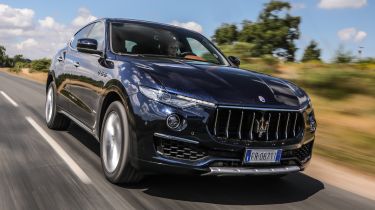New Maserati Levante 2018 review
The Maserati Levante is a well-rounded performance SUV, but this diesel is the weakest engine in the range…

Desirable, great to drive and comfortable, the Levante is a well-rounded performance SUV. The expanding range is hitting its stride in its third year, but the introduction of a more affordable V6 petrol makes this diesel harder to recommend than ever. Unless you cover big distances on a regular basis, this is the weakest engine in the range.
The idea of an iconic Italian marque like Maserati building an SUV seemed horrifying as far back as… Well, mid-2016, when the Levante became a production reality.
But opinions have turned in favour of a market that Maserati simply couldn’t ignore. The 2019 Model Year brings the second round of updates since the Levante’s launch, but can the tweaks turn it into a Porsche Cayenne beater?
• New Maserati Levante gains 346bhp V6 engine
The good news is that there’s more choice than ever. UK buyers had to make do with a rather un-Maserati-like V6 diesel at launch, but a 424bhp V6 petrol ‘S’ was introduced last year, and now a 345bhp petrol joins them. The new V6 twin-turbo costs from £61,425 - roughly £3k more than the diesel.
There’s also a pair of V8s: a 542bhp GTS and the flagship Trofeo, which packs an additional 40bhp and a 189mph top speed. While UK bosses are keen to offer the GTS, sales here are still unconfirmed. Electrification will feature in Maserati’s future, too.
Used - available now

2020 Jaguar
F-Pace
31,770 milesAutomaticDiesel3.0L
Cash £25,890
2024 Peugeot
5008
40,906 milesAutomaticDiesel1.5L
Cash £20,197
2023 Ford
Focus
14,538 milesManualPetrol1.0L
Cash £17,087
2023 Jaguar
E-PACE
20,181 milesAutomaticDiesel2.0L
Cash £24,287The entry-level V6s are offered in three trim levels: Levante, GranLusso and GranSport. The GranSport gets new, more aggressive front and rear bumpers inspired by the Trofeo, and rides on 20-inch alloy wheels. The GranLusso is the more luxurious alternative, featuring more chrome trim and 19-inch wheels. LED Matrix lights are available for the first time, and there are two new paint colours. The dark blue shown in these pictures is one of them, and features a glass flake which gives a spectacular sparkle in sunlight.
Inside, there’s a new gear selector, tweaked switchgear, and new trim inserts. It’s nothing radical – so as before it’s a mix of the sublime and the ridiculous. The aluminium shift paddles, soft leather, and electrically adjustable pedals are wonderful, but things like the shonky cup holder lid let the side down.
The 8.4-inch touchscreen infotainment system has received attention, but the systems from BMW and Porsche look prettier and are easier to use. It does benefit from Apple CarPlay and Android Auto, though.
For a car that’s longer and wider than a Porsche Cayenne, it’s not as spacious as you’d expect, either - rear seat knee room and boot space lag well behind the Porsche. There’s no seven-seat option either, which leaves it trailing alongside flashier versions of the Land Rover Discovery and Audi Q7.
Little separates the latest Levante from the old one out on the road, and that’s a good thing. It may weigh comfortably over two tonnes, but that mass is kept in brilliant control; that it does so while maintaining such a soft, yielding ride makes it all the more impressive. The steering, though electrically assisted, is precise and well-weighted, and there’s loads of grip. In normal driving, 100 per cent of the drive is sent to the back wheels, with power only sent to the fronts when slip is detected.
That slip is kept in check thanks to the introduction of Integrated Vehicle control. First seen on the Ghibli, it’s an ESP system that works proactively rather than reactively against a loss of grip, meaning intervention is so progressive it’s almost seamless. It’s a smart system, but one drivers will rarely benefit from on public roads.
The 3.0-litre diesel driven here remains unchanged. It delivers decent performance, and even sounds fairly smooth by diesel standards. Unfortunately, when against such wonderful Ferrari-developed V6 petrol alternatives - both faster and more tuneful - it’s tough to recommend.
Sure, the diesel is more frugal, but is that why you choose a Maserati? It’d be like pairing your hiking boots with a smart three piece suit – simply because those handcrafted Italian loafers wear out too quickly.










